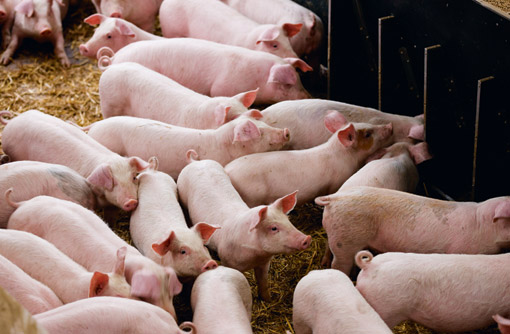Pig producers face up to contaminated feed

Pig farmers are being urged to look out for signs of mycotoxin poisoning after tests revealed extensive feed contamination.
Mycotoxins, which are caused by moulds and fungi and severely affect pig performance, were found in 90% of grain sampled by animal health company, Alltech UK. Straw bedding was also highly contaminated with multiple mycotoxins.
Last year’s cold and wet harvesting conditions are blamed for not only a higher presence of the organisms than in previous years, but a greater variety too.
Terry McArdle, pig technical sales manager for Alltech UK, says mycotoxins can quickly undermine pig health, productivity and reproductive performance.
“A mycotoxin challenge can be difficult to identify at the best of times, but this year keeping on top of the problem will be particularly tough,” he comments.
Signs of mycotoxins in pigs
- Poor fertility – for example, sows returning to heat.
- Reduced growing and finisher pig performance.
- Abortions and stillbirths, rectal and vaginal prolapse.
- Reddened vulvas and ear and skin necrosis.
- A combination of poor fertility and growth are likely signs of mycotoxin poisoning.Systems most at risk are those where mycotoxin binders are not added to feed. Dirty grain storage bins are also a contributory factor.
All pigs are vulnerable but the effects are greater in breeding animals and youngstock. One of the greatest challenges is achieving the correct diagnosis because the symptoms are similar to those of other illnesses.
Mark Hawe, pig adviser with the Department of Agriculture in Northern Ireland, says the signs can often be mistaken for those of leptospirosis. “An obvious symptom is poor fertility with sows returning to heat but often not all sows and gilts are affected.”
The performance of growing and finishing pigs can be affected too. “It has an impact on feed conversion and growth rate so it will take longer for growing pigs to achieve their finishing weights,” explains Dr Hawe.
A combination of poor fertility and growth are more likely to point to mycotoxin poisoning. “In herds where there are more sows repeating or where growing pig performance has dipped, farmers need to question if mycotoxin may be playing a part,” says Dr Hawe.
Other symptoms include abortions and stillbirths, rectal and vaginal prolapse and ear and skin necrosis.
BPEX knowledge transfer manager Lis Ravn says signs of mycotoxins vary and include reduced immunity and sudden performance drops. But a classic sign is reddened vulvas in female piglets. “If farmers think they have a problem they should contact their vet, who will be able to establish if mycotoxin poisoning is the problem,” she says. Testing feed and sampling straw can confirm the suspicion.
Adding binders to feed is the best form of defence because these absorb harmful mycotoxins, Ms Ravn advises. If the herd is already displaying signs of poisoning, this course of action will eliminate the source of contamination and help to restore health. “If the problem is eliminated the symptoms will improve,” she says.
Feed bins should be examined as a possible source of contamination. “I would strongly advise farmers to inspect the bins for any leaks,” says Ms Ravn. “Bins should be routinely emptied completely and washed out and dried out before the feed is put back in.”
Straw, another possible source of contamination, should not be used in bedding for breeding pigs and youngstock if it has been baled in damp conditions, as these animals are particularly sensitive to myxotoxins.
Read how one beef farmer is tackling mycotoxins in his beef herd
